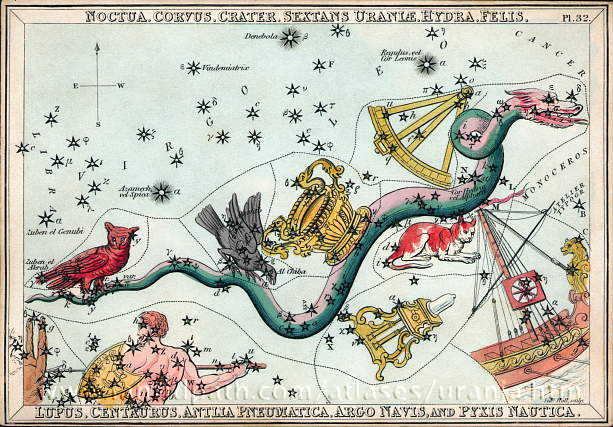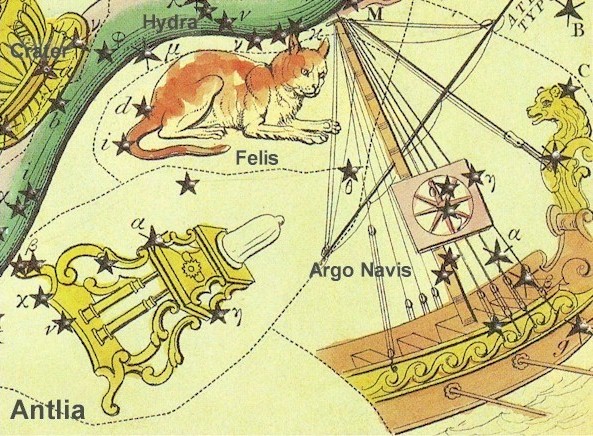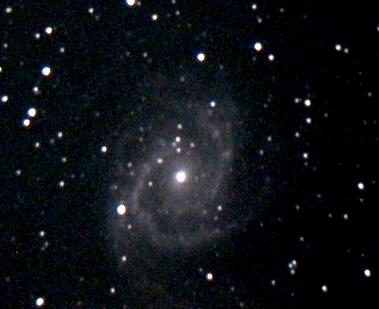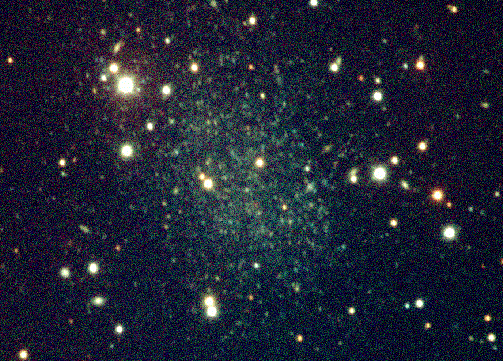Da Terra ao Céu ....
.....e ao Infinito
- As 88 Constelações
http://daterraaoceueaoinfinito.blogspot.com.br/
Os desenhos formados pelas estrelas - AS CONSTELAÇÕES - são como janelas que se abrem para a infinitude do universo
e que possibilitam nossa mente a ir percebendo que existe mais, bem mais, entre o céu e a terra...;
bem como percebendo que o caos, vagarosamente, vai se tornando Cosmos e este por nossa mente sendo conscientizado.
Quer dizer, nossa mente é tão infinita quanto infinito é o Cosmos.
Com um abraço estrelado,
Janine Milward
e que possibilitam nossa mente a ir percebendo que existe mais, bem mais, entre o céu e a terra...;
bem como percebendo que o caos, vagarosamente, vai se tornando Cosmos e este por nossa mente sendo conscientizado.
Quer dizer, nossa mente é tão infinita quanto infinito é o Cosmos.
Com um abraço estrelado,
Janine Milward
 |
| Mario Jaci Monteiro - As Cartas Celestes |
 |
Mario Jaci Monteiro - As Constelações, Cartas Celestes
- excerto apresentando ALFABETO GREGO, CONVENÇÕES E USO DA CARTA CELESTE
|
Da Terra ao Céu
e ao Infinito
Constelações, Estrelas e Objetos Celestes
(sob o ponto de vista do Mundo Ocidental)
Suas histórias, seus mitos, seus significados e suas sintetizadas descrições
Reunião das Informações e Compilação,
Tradução para a língua portuguesa (em alguns momentos)
bem como Comentários Pessoais:
Janine Milward
Os desenhos formados pelas estrelas - AS CONSTELAÇÕES - são como janelas que se abrem para a infinitude do universo e que possibilitam nossa mente a ir percebendo que existe mais, bem mais, entre o céu e a terra ...; bem como percebendo que o caos, vagarosamente, vai se tornando Cosmos e este por nossa mente sendo conscientizado.
Quer dizer, nossa mente é tão infinita quanto infinito é o Cosmos.
Quer dizer, nossa mente é tão infinita quanto infinito é o Cosmos.
Alguns dados
(tais como Ascensão Reta e Declinação, em muitos dos casos)
são época/equinócio 1980
e devem requerer do Caminhante do Céu
alguma pequena retificação.
Obrigada por sua compreensão.
Visitando os Sites abaixo,
você conseguirá informações atualizadas e preciosas
sobre os Objetos Celestiais de seu interesse:
NASA/IPAC EXTRAGALACTIC DATABASE –
NASA/IPAC Extragalactic Database (NED) - operated by the Jet Propulsion Laboratory, California Institute of Technology, under contract with the National Aeronautics and Space Administration.
THE NIGHT SKY ATLAS
The night sky atlas creates images of any part of the night sky, allowing easy location of any object. Detailed chart images show all stars visible to the naked eye, the constellations, Messier objects, and names of the brightest stars.
The Internet STELLAR DATABASE
- stars within 75 light-years. (Plus some of the more well-known "name brand" stars farther away.)
DOCdb
Deep Sky Observer's Companion – the online database
 |
| http://www.ianridpath.com/atlases/urania/urania32.jpg |
 |
| http://catalogo.museogalileo.it/galleria/PompaPneumatica.html http://catalogo.museogalileo.it/approfondimento/PompaPneumatica.htm lhttp://www.museogalileo.it/ |
ANTLIA PNEUMATICA,
A MÁQUINA PNEUMÁTICA
A MÁQUINA PNEUMÁTICA
Posicionamento:
Ascensão Reta 9h23m / 11h3m Declinação - 24o 3’ a - 40o 1’
História:
Constelação adicionada por La Caille, em 1732, sob o nome de Machina Pneumática.
Acessando
você encontrará Informações bem interessantes sobre o
significado da nomeação ANTLIA, suas principais Estrelas e excertos do texto de
Richard H. Allen contando a História da Constelação ANTLIA.
 |
| Urania's Mirror, 1825 |
em Antlia, a Máquina Pneumática
| Star | R A | Decl 2000 | Lat | Mag | Sp | ||
| epsilon [ε] | 09h 29m 14.7s | −35° 57′ 05″ | -47 21 09 | 4.64 | M0 | ||
| alpha [α] | 10h 27m 09.1s | −31° 04′ 04″ | -37 25 38 | 4.42 | M0 | ||
| iota [ι] | 10h 56m 43.1s | -37° 8' 16" | -39 49 02 | 4.70 | G5 |
The Antlia Cluster (or Abell S0636) [4] is a cluster of galaxies located in the Hydra-Centaurus Supercluster. The Antlia Cluster is the third nearest to our Local Group after the Virgo Cluster and Fornax Cluster.[6] The cluster's distance from earth is 40.5 Mpc (132.1 Mly) to 40.9 Mpc (133.4 Mly)[5] and can be viewed from earth in the constellation Antlia.[5][7] The Antlia Cluster should not be confused with the Antlia Dwarf Galaxy.[5]
The cluster is classified, as a rare Bautz-Morgan type III cluster,[4][3] meaning the cluster has no dominating brightest cluster galaxy(cD).[8] Although, this cluster is dominated by two massive elliptical galaxies, NGC 3268 and NGC 3258, the cluster has about 234 galaxies in total.[4][5] The cluster is very dense compared to other clusters such as Virgo and Fornax, thus containing early-type galaxies and a larger portion of dwarf ellipticals.[5][7] The Cluster is split into two groups, The Northern subgroup gravitating around NGC 3268, and the Southern subgroup centered on NGC 3258.[5]
The cluster has an overall redshift of z = 0.0087, implying the cluster like most objects in the universe are expanding away from ourLocal Group and others.[4] Using the now obsolete scientific satellite ASCA, X-ray observations show the cluster is almost isothermal, with a mean temperature of kT ~ 2.0 keV.[4]
A list of the named objects in the Antlia Cluster: NGC 3267, NGC 3568, NGC 3258, NGC 3269, NGC 3271,[4][6] NGC 3258A, NGC 3258B, NGC 3260, NGC 3267, NGC 3268, NGC 3273.[6]
LEIA EM
in the Antlia cluster?
B. Dirsch1, T. Richtler1, and L. P. Bassino2
NGC 3268 is an elliptical galaxy in the constellation Antlia. It is a member of the Antlia Cluster, which lies about 40.7 megaparsecs(132.7 megalight-years) away.[2]
NGC 3258 is an elliptical galaxy in the constellation Antlia. It is a member of the Antlia Cluster, which lies about 40.7 megaparsecs(132.7 megalight-years) away.[2]
NGC 3267 is a lenticular galaxy in the constellation Antlia. It is a member of the Antlia Cluster, which lies about 40.7 megaparsecs(132.7 megalight-years) away.[2]
http://en.wikipedia.org/wiki/NGC_3267
NGC 3269 is a lenticular galaxy in the constellation Antlia. It is a member of the Antlia Cluster, which lies about 40.7 megaparsecs(132.7 megalight-years) away.[2]
http://en.wikipedia.org/wiki/NGC_3269
NGC 3271 is a barred spiral galaxy[2] in the constellation Antlia. At magnitude 11.7, it is the brightest spiral galaxy in the Antlia Cluster, which lies about 40.7 megaparsecs (132.7 megalight-years) away.[3]
http://en.wikipedia.org/wiki/NGC_3271
NGC 3260 is an elliptical galaxy in the constellation Antlia. It is a member of the Antlia Cluster, which lies about 40.7 megaparsecs(132.7 megalight-years) away.[2]
http://en.wikipedia.org/wiki/NGC_3260
NGC 3267 is a lenticular galaxy in the constellation Antlia. It is a member of the Antlia Cluster, which lies about 40.7 megaparsecs(132.7 megalight-years) away.[2]
http://en.wikipedia.org/wiki/NGC_3267
NGC 3268 is an elliptical galaxy in the constellation Antlia. It is a member of the Antlia Cluster, which lies about 40.7 megaparsecs(132.7 megalight-years) away.[2]
http://en.wikipedia.org/wiki/NGC_3268
http://en.wikipedia.org/wiki/NGC_3267
NGC 3269 is a lenticular galaxy in the constellation Antlia. It is a member of the Antlia Cluster, which lies about 40.7 megaparsecs(132.7 megalight-years) away.[2]
http://en.wikipedia.org/wiki/NGC_3269
NGC 3271 is a barred spiral galaxy[2] in the constellation Antlia. At magnitude 11.7, it is the brightest spiral galaxy in the Antlia Cluster, which lies about 40.7 megaparsecs (132.7 megalight-years) away.[3]
http://en.wikipedia.org/wiki/NGC_3271
NGC 3260 is an elliptical galaxy in the constellation Antlia. It is a member of the Antlia Cluster, which lies about 40.7 megaparsecs(132.7 megalight-years) away.[2]
http://en.wikipedia.org/wiki/NGC_3260
NGC 3267 is a lenticular galaxy in the constellation Antlia. It is a member of the Antlia Cluster, which lies about 40.7 megaparsecs(132.7 megalight-years) away.[2]
http://en.wikipedia.org/wiki/NGC_3267
NGC 3268 is an elliptical galaxy in the constellation Antlia. It is a member of the Antlia Cluster, which lies about 40.7 megaparsecs(132.7 megalight-years) away.[2]
http://en.wikipedia.org/wiki/NGC_3268
NGC 2997
NGC 2997 é uma galáxia espiral localizada a cerca de cinquenta e cinco milhões de anos-luz (16,86 megaparsecs) de distância na direção da constelação da Máquina Pneumática. Possui uma magnitude aparente de +11,2, uma declinação de -31° 11' 25" e uma ascensão reta de 9 horas, 45 minutos e 38,5 segundos.
A galáxia NGC 2997 se afasta de nós a uma velocidade aproximada de 1100 km/s. O núcleo galáctico encontra-se rodeado por uma cadeia de nuvens quentes gigantes de hidrogênio ionizado.
|
NGC 2997 (infravermelha)
| |
Descoberto por
| |
Data de descoberta
| |
Dados observacionais (J2000)
| |
Tipo
|
espiral barrada (SBc)
|
09h 45m 38,6s
| |
-31° 11' 26"
| |
Distância
| |
0,003626
| |
9,4
| |
Dimensões
|
8,9' × 6,8'
|

Na fronteira entre as constelações Antlia e Vela (Navio), vamos encontrar NGC 3132, A NEBULOSA DO ANEL DO SUL:
NGC 3132, also known as the Eight-Burst Nebula,[2] the Southern Ring Nebula,[2] is a bright and extensively studied planetary nebulain the constellation Vela. Its distance from Earth is estimated at about 550 pc. or 2,000 light-years.[2]
| NGC 3132 | |
|---|---|
 | |
| Observation data (Epoch J2000.0) | |
| Right ascension | 10h 07m 01.7640s[1] |
| Declination | −40° 26′ 11.060″[1] |
| Distance | 2,000 ly[2] |
| Apparent magnitude (V) | 9.87[1] |
| Apparent dimensions (V) | 62″ × 43″[3] |
| Constellation | Vela |
| Physical characteristics | |
| Radius | 0.4 ly[2] |
| Other designations | Eight-Burst Nebula,[2]Southern Ring Nebula,[2] Caldwell 74 |
 |
| Ilustração realizada no Programa Stellarium e trabalhada no Programa Corel Photo-Paint X3 |
NGC 3244, a spiral galaxy in Antlia
NGC 3244 é uma galáxia espiral (Sc) localizada na direcção da constelação de Antlia. Possui uma declinação de -39° 49' 40" e uma ascensão recta de 10 horas, 25 minutos e 28,8 segundos.
A galáxia NGC 3244 foi descoberta em 22 de Abril de 1835 por John Herschel.
| Descrição |
English: This new image of the spiral galaxy NGC 3244 was taken with the help of the President of the Czech Republic, Václav Klaus, during his visit to ESO’s Paranal Observatory [1], on the night of 6 April 2011. The Czech Republic joined ESO in 2007, and this was the first visit of the country’s President to an ESO site.
This galaxy has attracted considerable interest from astronomers over the past nine months, thanks to the violent death of one of its stars, which was discovered on 27 June 2010. This supernova explosion, now known as Supernova 2010ev (SN 2010ev), is still visible as the — now faint — blue dot nestled within one of the thick spiral arms just to the left of the galaxy’s nucleus.
To the right of the galaxy, an unremarkable foreground star in our own Milky Way, TYC 7713-527-1, shines brightly enough to catch our attention. Although the star seems a great deal brighter than SN 2010ev, this is actually an illusion created by the large difference in the distances of the two objects. The galaxy is much further away, at a distance of about 90 million light years, while the star lies thousands of times closer, within our own galaxy.
At its brightest, SN 2010ev reached an apparent magnitude of about 14, making it about 1000 times dimmer than the naked eye can see, but it was still the third brightest supernova observed in 2010. In fact, if the supernova had been as close to Earth as TYC 7713-527-1, it would have been easily visible to the naked eye, unlike the aforementioned star.
The image was taken using the FORS2 instrument on the ESO Very Large Telescope (VLT). The filters used for the image were B, V and R, which were coloured blue, green and red respectively. A framed print of the President’s Galaxy has been presented to Václav Klaus, as a memento of his visit to Paranal. |
| Data | |
| Origem | http://www.eso.org/public/images/potw1120a/ |
| Autor | ESO http://pt.wikipedia.org/wiki/Ficheiro:NGC_3244.tif |

http://www.eso.org/public/archives/images/screen/potw1120a.jpg
About the Object
| Name: | NGC 3244, TYC 7713-527-1 |
| Type: | • Milky Way : Star • Local Universe : Galaxy : Type : Spiral • X - Galaxies • X - Stars |
| Distance: | 90 million light years |
| Constellation: | Antlia |
Coordinates
| Position (RA): | 10 25 28.92 |
| Position (Dec): | -39° 49' 38.86" |
| Field of view: | 3.10 x 2.43 arcminutes |
| Orientation: | North is 89.8° right of vertical http://www.eso.org/public/images/potw1120a/ |
NGC 3347 é uma galáxia espiral barrada (SBb) localizada na direcção da constelação de Antlia. Possui uma declinação de -36° 21' 12" e uma ascensão recta de 10 horas, 42 minutos e 46,6 segundos.
A galáxia NGC 3347 foi descoberta em 1 de Maio de 1834 por John Herschel.http://pt.wikipedia.org/wiki/NGC_3347
John Herschel (1847) Cape Observations
This 12.8 magnitude spiral in Antlia was discovered by Sir John Herschel at the Cape of Good Hope with an 18-inch f/13 speculum telescope. He recorded it as "pretty faint, small, round, very suddenly much brighter in the middle to a star of 12th magnitude." His next observation reads: "Not very faint, round, suddenly a little brighter in the middle, 15 arcsec across. The first of three." This galaxy lies in the half-degree grouping of NGC 3347, 3354 & 3358.

Hubble's Glitter galaxy: The ESO 318-13 galaxy

http://www.nasa.gov/images/content/712462main_potw1249a.jpg
The brilliant cascade of stars through the middle of this image is the galaxy ESO 318-13 as seen by the NASA/ESA Hubble Space Telescope. Despite being located millions of light-years from Earth, the stars captured in this image are so bright and clear you could almost attempt to count them.
Credit: ESA/Hubble & NASA
Aglomerado em Antlia:
Apesar de ser o segundo mais rico aglomerado pertencente ao superaglomerado Hydra, o aglomerado Antlia não nos impressiona tanto quanto o aglomerado Hydra. Antlia aglomerado é similar ao aglomerado Fornax.
Assim como o aglomerado Hydra, o aglomerado Antlia não fotografa muito bem. As galáxias são espraiadas ao longo de um grau no céu, de forma que existem muitas estrelas de primeiro plano.

Credit and Copyright: M. Irwin (RGO), A. Whiting & G. Hau (IoA, Cambridge)
O que sempre me surpreende - seja em Constelações médias a grandes emtamanho figurado ou seja em Constelações pequenas e muito pequenas -, é que sempre encontraremos um sem-número de objetos celestiais podendo por nós serem estudados!
Com um abraço estrelado,
Janine Milward
DOCdb
Deep Sky Observer's Companion – the online database
listing objects by constellation
Searching for all objects in Antlia.
The Night Sky Atlas
| Visible in October before dawn, to June after dusk, best in February. |
DSO Names - The Night Sky Atlas
Common Name
|
Catalog Numbers
|
RA
hours |
DEC
degrees |
Notes
|
Antlia: Visible in October before dawn, to June after dusk, best in February.
| ||||
10h 04.1m
|
-27° 20.0´
|
in Local Group
| ||
Asterisms - The Night Sky Atlas
Name
|
Mag
|
Size
|
Description
|
Antlia: Visible in October before dawn, to June after dusk, best in February.
| |||
6
|
3' X 2'
|
A tiny curved arc of 4 pretty bright stars and two fainter members; from Magda Streicher
| |
Principal Stars of Antlia - The Night Sky Atlas
http://www.nightskyatlas.com/starata.jsp?id=ANT
Multiple Stars of Antlia - The Night Sky Atlas
http://www.nightskyatlas.com/multipleStars.jsp?id=ANT
NGC Objects in Antlia - The Night Sky Atlas
http://www.nightskyatlas.com/ngcData.jsp?id=ANT
IC Objects in Antlia - The Night Sky Atlas
http://www.nightskyatlas.com/icData.jsp?id=ANT
Galaxy Clusters of Antlia - The Night Sky Atlas
http://www.nightskyatlas.com/catAbell.jsp?id=ANT
Os desenhos formados pelas estrelas são como janelas que se abrem para a infinitude do universo e que possibilitam nossa mente a ir percebendo que existe mais, bem mais, entre o céu e a terra...; bem como percebendo que o caos, vagarosamente, vai se tornando Cosmos e sendo por nossa mente conscientizado.
Quer dizer, nossa mente é tão infinita quanto infinito é o Cosmos.
Quer dizer, nossa mente é tão infinita quanto infinito é o Cosmos.
COM UM ABRAÇO ESTRELADO,
Janine Milward
Na fronteira entre as constelações Antlia e Vela (Navio), vamos encontrar NGC 3132, A NEBULOSA DO ANEL DO SUL
:
:
 |
NGC 3132 is a striking example of a planetary nebula. This expanding cloud of gas, surrounding a dying star, is known to amateur astronomers in the southern hemisphere as the 'Eight-Burst' or the 'Southern Ring' Nebula.
Credit:
Hubble Heritage Team (STScI/AURA/NASA/ESAhttp://www.spacetelescope.org/images/opo9839a/
|



